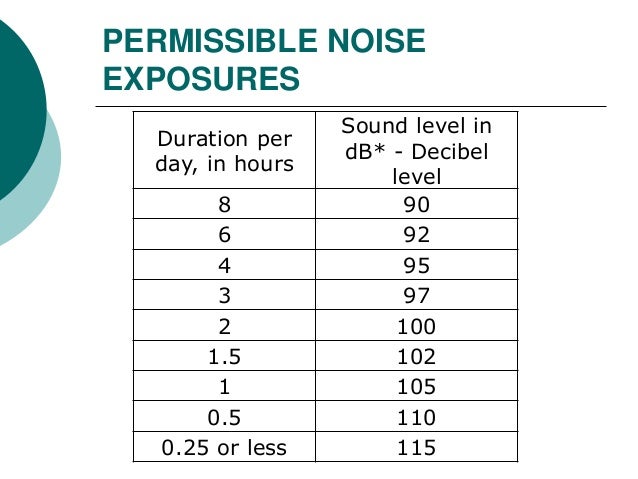

Refer to Appendix B: Determining noise exposure and calculating L ex, 8 for information on non-standard work shifts. For example, a constant exposure to 84 dBA over a 12 hour period would mean that worker protection is mandated, because the L ex, 8 exposure limit for noise would be exceeded. This does not mean that protection is required only when sound levels exceed 85 dBA. This is similar in concept to the TWA exposure limit for a biological or chemical agent in the Regulation respecting the Control of Exposure to Biological or Chemical Agents (Regulation 833). An exposure limit of 85 dBA L ex, 8 may be thought of as the time-weighted average ( TWA) exposure limit for noise for an 8 hour shift. The only applicable exposure limit is the 85 dBA, L ex, 8.Ī worker's exposure to noise levels generally varies throughout the day. This requirement is intended to protect workers from exposure to sound levels above the occupational exposure limit of 85 dBA averaged over an 8 hour work shift, referred to as 85 dBA L ex, 8.

“…every employer shall ensure that no worker is exposed to a sound level greater than an equivalent sound exposure level of 85 dBA, L ex, 8”. “Every employer shall take all measures reasonably necessary in the circumstances to protect workers from exposure to hazardous sound levels.”Īn Ontario employer, who is covered by the OHSA, has a legal obligation and a general duty to take all measures reasonably necessary in the circumstances to protect workers from exposure to all hazardous sound levels. The following sections provide guidance on the provisions of the Regulation with quotes. The Regulation also requires HPDs to be used and maintained in accordance with the manufacturer’s instructions. manufacturer’s information about its use and limitations.attenuation or reduction in sound level provided by the HPD.sound levels to which a worker is exposed.The Regulation requires HPDs to be selected with regard to the: Selection, care and use of hearing protection devices inspection and maintenance, and, if applicable.The training and instruction must address: Worker trainingĮmployers who provide workers with HPDs must provide them with adequate training and instruction on their care and use. Where it is practicable to do so, employers must post a clearly visible warning sign at every approach to an area in the workplace where the sound level regularly exceeds 85 dBA. personal protective equipment in the form of HPDs, subject to the restrictions stated in the Regulation.work practices such as equipment maintenance (to keep it quieter) or scheduling to limit a worker’s exposure time.engineering controls to reduce noise at the source or along the path of transmission.
When the prescribed exposure limit would be exceeded, employers are required to put in place protective measures to proactively reduce workers’ noise exposure. The regulation requires that every employer shall ensure that no worker is exposed to a sound level greater than a time-weighted average exposure limit of 85 dBA (decibels measured on the A-weighting network of a sound-level meter) measured over an 8-hour work day.Įmployers must comply with this limit following the “hierarchy of controls”, which emphasizes the use of engineering controls and work practices to protect workers and places restrictions on the use of hearing protection devices ( HPDs) by workers. Regulatory requirements - overview Employer’s duty to protect workers from hazardous sound levelsĮmployers have a duty to take all measures reasonably necessary in the circumstances to protect workers from exposure to hazardous sound levels. The Noise Regulation applies to all workplaces covered under the Occupational Health and Safety Act ( OHSA). Application What workplaces are covered by the Noise Regulation ( O.


 0 kommentar(er)
0 kommentar(er)
